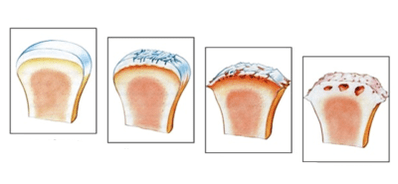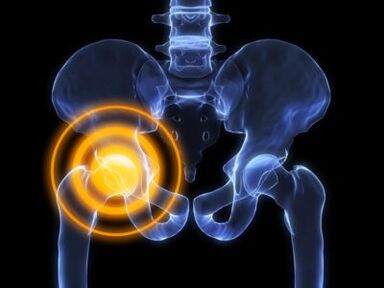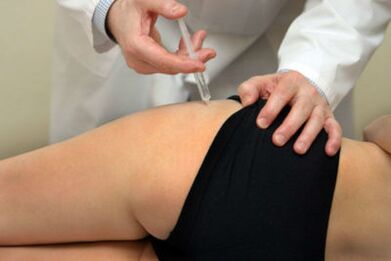Hip arthritis is a complex disease with specific symptoms and complex treatments.The disease occurs in the context of metabolic disease in the cartilage tissue of the joint cavity and femoral head.
Arthritis of the hip or Coksartrosis is more common in the elderly.It is generally believed that inflammatory response plays a major role in the pathogenesis of the disease.After extensive research, it has been proven that arthritis occurs in diseases of atherosclerosis and metabolic diseases.
The nature of disease
Coksartrosis is a metabolic disease based on atrophy and degenerative changes in hip cartilage tissue.
You cannot confuse arthritis with arthritis.Unlike arthritis with arthritis, non-infectious (sterile) inflammation has developed and developed over the years.
The pathogenesis of development:
- Violating metabolic processes in cartilage.Cartilage tissue uses diffusion to receive nutrients.The slightest inflammation or edema leads to a lack of trace elements and minerals.
- In the context of the nutritional impairment process, the atrophic changes begin, the cartilage tissue is improved, and the amount of joint fluid and chondrocytes is reduced.
- Due to the insanity and destruction of the cartilage, severe pain began and the amplitude of joint movement decreased.
- Cartilage fabrics are very complex, with fabulous gaps narrowing and joint malnutrition occurring.
It takes more than a year until the malnutrition attacks.The disease can only stop in the first stage, and as the third stage of osteoarthritis develops, treatment aims to relieve symptoms and accuse patients of their lives, which is a substitute for drug-in-propthetics.
reason

The disease is multibiological and has many conditions and factors that can cause arthritis or cause its progression.If no cause of hip arthritis is detected, this disease is called idiopathic arthritis.
The disease is not hereditary, but the genetic pathology of abnormal cartilage development may lead to hip arthritis.
In addition, the cause of coksartrosis may be such a disease:
- PERTES Syndrome - The disease is characterized by violation of the delivery of nutrients to the cartilage tissue of the joints and femoral head.It occurs in childhood, mainly when boys get sick.
- Congenital dislocation and subluxation of the femur.During the injury, inflammatory reactions and sterile melting of the cartilage tissue and femoral head may occur.
- Necrosis of the thoracic head.It occurs due to damage to the superior artery, which attaches to the top of the head.
- Rheumatoid arthritis.In the context of the action of toxins or autoantibodies, exudative inflammation occurs in the joints.
Given the slow progression of the disease, the disease can be on one side and two aspects.
There are many factors that cause joint development, including:
- Spine disease (Kyphosis, Lordosis, scoliosis);
- Metabolic diseases of connective tissue;
- Violating the blood supply of joints;
- atherosclerosis of large blood vessels;
- stress status;
- hip dysplasia;
- Congenital deformation of lower limbs;
- infectious disease;
- an inactive lifestyle;
- Drink alcohol, smoke;
- Old age.
Don't forget that people who engage in stretching are at great risk as adults.
Again, one of the reasons may be traumatic damage to joint components.After tissue damage occurs, an inflammatory reaction occurs, so connective tissue can be used instead of cartilage.
symptom

Because the disease is slowly developing, patients do not always pay attention to their first signs.It should be noted that through early diagnosis, the chances of disease remission increase.It is important to start treatment earlier because this avoids the development of oxidative strengthening and complete osteoarthritis.
With the joints of the hip joint, symptoms of varying intensity may occur depending on the load and extent of the disease.
Clinical pictures of hip osteoarthritis:
- The pain sensation turned into severe pain on the front and sides of the thighs.Patients complain that the load on the thighs on the turns or joints can be greatly injured.
- The unpleasant sensations that the groin produces in the groin when walking, sometimes they can be combined with thigh pain.
- Stiffness and limitations of hip limb mobility.First, throw away the features on one side, then everyone else.
- The sound is unpleasant when walking and the connector can be clicked or zipped.Continuous pathological sounds may be the only sign of the disease.
- Stiff in the morning, passing a few hours before dinner or before dinner.
Sometimes the possible consequences are ignored, and people start taking drugs for symptom treatment, thus masking the progress of the cartilage destruction process.
Disease degree
The clinical picture depends on the degree of jointness of the hip joint and the patient's body's responsiveness.If symptoms usually occur, changes occur in the X-ray.In medical practice, three radiology stages are habitually distinguished, each of which has its own characteristics.
Regarding the degree of jointness of X-rays changes:
Grade 1 arthritis
It is performed with minimal clinical manifestations, so patients rarely seek help from their doctors.Through early diagnosis of the disease, patients increase their chances of complete recovery.The initial period of the disease is characterized by small pain in the pelvis and thighs, which increases in the context of physical fatigue or prolonged walking.In terms of frequency of performance, the second is the symptoms of groin pain.At 1 degree, the pain is pulling and rarely occurs.The volume of the action has been completely saved.In X-rays, visualize minor changes.
Level 2
If there is a second degree, the patient begins to bother more acute and frequent pain, which may occur at rest.Usually, symptoms appear at night and stiffness in the morning will not pass before dinner.During a prolonged transition period, symptoms of lax occur and a person cannot be filled with sick joints.Discomfort occurs during flexion or squat, and the degeneration of the cartilage progresses.In the context of this change, legs can be shortened and atrophy of the hip muscles and pelvis occurs.On X-rays, the stenosis of the joint space can be seen, and the periosteal reaction will increase.A large number of bone plants were found in the cavity of the joints.
The final or diffuse third stage of arthritis
The third stage is characterized by motor dysfunction in the lower limbs.The patient complains about the ongoing pain, which occurs for no reason.The limbs are shortened by more than 5%, ankylosing occurs and joints lose their ability to move.X-rays showed the complete closure of the joint space and the large number of bone genera in the context of bone deformation.Level 3 processing is only performed through operation.
Treatment method

The choice of treatment depends on the degree of osteoarthritis.In the first phase, comprehensive conservative treatment was used.The most difficult part is the second stage, because conservative therapy is ineffective and the indications for the surgery are not enough.Only with the first development of the disease, arthritis can be cured.
After diagnosing the diagnosis of hip joints, the doctor chose the treatment method.Most commonly used:
- Conservative treatment of drugs;
- surgical treatment;
- Exercise therapy and massage.
Each treatment has its own characteristics, changes and specific goals.Conservative therapy is used for such purposes:
- Struggle with the cause.For example, metabolic or hormonal diseases can be corrected.
- Symptomed treatment is designed to relieve patients' lives and relieve scoring symptoms.For this purpose, non-replacement anti-inflammatory drugs are used.In most cases, use NSAIDS to use diclofenac sodium, Nimesulide, ibuprofen.
To eliminate persistent pain, NSAID is taken almost every day, which can affect the patient's gastrointestinal tract and lead to the development of peptic ulcers.
The surgical intervention is represented by third-level articulation, which is the only way to restore walking function.The essence of this method is a complete or partial replacement of the joints with the titanium plant.
Media sports are an integral part of any rehabilitation measure.Exercise therapy and massage are designed to improve blood flow to the joints.Likewise, exercise therapy is used to reduce the risk of ankylo oxidizing drugs.
You should be careful when doing exercises, as you may be damaged and fractured.Strategies and exercises should be chosen by the doctor based on your personal characteristics and clinical image of the disease.



















